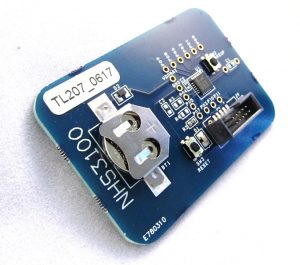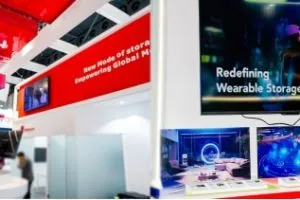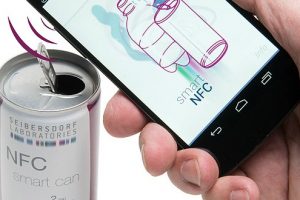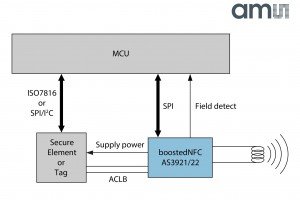The technologies behind the internet of things (IoT) is making the world around us more intelligent. In many implementations, the sensor nodes that are installed to relay data constantly to servers in the cloud will provide a view of the environment on a minute-by-minute basis, but there are numerous use-cases where continuous connectivity is either impractical or unnecessary.
RFID
There are numerous situations where cost or size limitations mean it is impractical to have the system continuously powered through a battery or energy harvester. An example now in mass production is the RFID tag used to identify products in a supply chain.
Many product tags in use today are passive devices that contain an antenna, RF interface, power converter and memory but no internal power source. The electromagnetic field generated by the RFID reader provides the energy needed by the tag to send a message back. The first generations of RFID tag employed a relatively simple protocol that was suitable for reading a string of digits that identify a single product.
The introduction of the nearfield communication (NFC) protocol greatly expanded the capability of RF-powered tags. Sony and Philips Electronics began work on the standard in 2002, developing a protocol that was approved as a standard by the ISO and IEC in 2003. Shortly afterwards, together with cellular handset maker Nokia the companies formed the NFC Forum to promote applications for the short-range wireless protocol.
Operating at a frequency of 13.56MHz, tags become active when they come within 10cm of a reader. In many practical applications, the NFC-enabled tag touches the reader’s external surface before the transaction begins. Compared to protocols such as Bluetooth, data transfer occurs at a relatively low rate: from around 100kbit/s to a little more than 400kbit/s. An important distinction between NFC and earlier RFID protocols is the support for richer two-way interactions, which can be encrypted.
Data transmission from a listening device can be achieved using load modulation, a technique that takes advantage of inductive coupling. A variation in the impedance of a ’listening’ device such as a tag causes amplitude or phase changes in the antenna voltage of the polling device. When full bidirectional communication is employed, the tag and reader alternate between polling and listening. However, this mode calls for a power source inside the tag whereas the simple load-modulation protocols allows use with battery-less passive tags.
Payment processing
Payment processing, one of the key early applications for NFC, took advantage of the encryption support. The act of touching an NFC-enabled device on top of the reader satisfies two important conditions. One is to provide a secure wireless connection but one that avoids the need to insert a card into a reader in order to make a connection using the pins of a traditional chip-and-PIN terminal. In addition, by promoting the gesture of touching a card or phone to the reader followed by a beep or light to show a successful transaction, the technique provides the user with the confidence that they alone are responsible for initiating the transaction.
For similar reasons, NFC has become the protocol of choice for transportation applications – providing travellers with the easy ability to pay the fare as they board a train or bus simply by touching a payment card or dedicated tag on the surface of a reader.
Personal-health
In personal-health applications, which will also often call for encryption support, the touch interaction provides the user of being in control of when data is delivered or retrieved as well as the convenience of being able to use sensors that have no internal power source. One application that has appeared recently that demonstrates this is a UV sensor. Cosmetics company L’Oreal discovered after a consumer study and feedback that a stretchable skin sensor it developed and released in 2016 had helped users demonstrate behaviours that led to less risky exposure to the sun’s UV rays.
At the Consumer Electronics Show at the start of 2018, L’Oreal followed My UV Patch with a device intended to allow longer-term monitoring of UV exposure. UV Sense was the first battery-less electronic sensors to measure and store UV exposure data for up to three months. Less than 2mm thick and less than a centimetre in diameter, the sensor can easily be worn for periods of up to two weeks on a thumbnail with a single application of adhesive.
The battery-less sensor takes advantage of the power supplied by an NFC-enabled smartphone to transfer data to an app that the wearer can use to determine their exposure over long periods of time. The design of the tag ensures the data remains personal and its transfer is under the control of the user. As a battery-less design, the tag is kept small and unobtrusive.
There are other applications for sensors and NFC in healthcare. An application for which NXP Semiconductors designed the NHS3152 is therapy adherence. The NFC-enabled NHS3152 interfaces to a network of resistive strips that, typically, are laid out under the foil surface of a strip of medicinal pills. As each pill is taken, the device notes the sudden change in resistance when the foil is broken and when the action took place. It records the action ready for transfer to a reader using its embedded NFC interface. The design allows operation with a small power source and ensures data is only transferred when scanned with an approved reader, which helps maintain medical confidentiality.
Impractical environments
In supply-chain and distribution applications, the combination of tag functionality and sensing makes it easier to deploy IoT solutions to environments where conventional sensor nodes would be impractical and expensive. In food transport a key requirement is for temperature and other environmental factors to be controlled. The interior of a truck may be fitted with a sensor node monitors overall levels but this may not provide data at a sufficient level of granularity to provide assurance. The important factor in these applications is that an individual consignment is kept above or below certain critical temperatures to be declared fit to eat.
Although it is possible to fit a sensor module that maintains regular contact with cloud servers though a gateway mounted in the truck, this demands that the entire fleet is made compatible with that module and with a backbone network. What is important, however, is accessing the data for the consignment when it reaches a major waypoint and is transferred to a different delivery service, or is delivered to the end customer. It is at these points that the consignment’s environmental data can be read out using dedicated readers. As a result, food-transport and similar use-cases are highly suited to implementation using NFC-enabled tags. The various sensors record data at regular intervals or when thresholds are exceeded; the database for each trip is then downloaded when the tag is passed through an RF gateway or scanned by a portable reader.
In other cases, the environmental sensors may be fixed in place in warehouses or factories. Although it may seem advantageous for these sensors to use a permanent RF connection through Bluetooth or Zigbee, persistent wireless connections may be impractical because of interference from other equipment or power constraints in those locations. If the equipment or storeroom locations require visual checks in addition to data pickups, the use of NFC to access their internal databases can represent a more appropriate solution.
Fixed and mobile
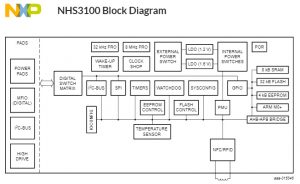 Support for both fixed and mobile environmental sensing with NFC data transmission is provided by devices such as NXP’s NHS3100 (pictured, top and right). This is an IC optimised for temperature monitoring and logging and includes an embedded NFC interface. It has its own internal temperature sensing and supports direct connection to a battery where independent power is required.
Support for both fixed and mobile environmental sensing with NFC data transmission is provided by devices such as NXP’s NHS3100 (pictured, top and right). This is an IC optimised for temperature monitoring and logging and includes an embedded NFC interface. It has its own internal temperature sensing and supports direct connection to a battery where independent power is required.
Thanks to devices such as these, NFC can fill in the areas of the IoT where constant connectivity is impractical or undesirable and to help enable sensor applications that cannot use internal power sources.
Ross Murgatroyd, Senior Global Product Manager at Farnell
 Electronics Weekly
Electronics Weekly
